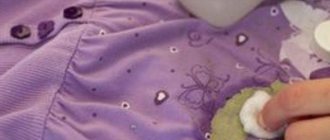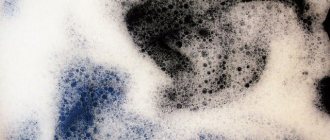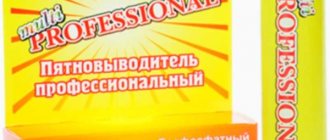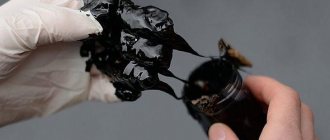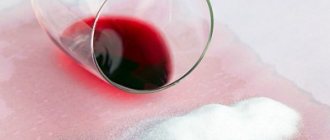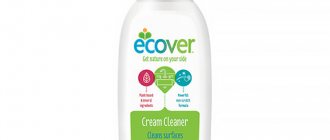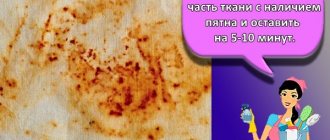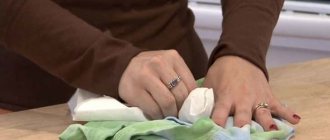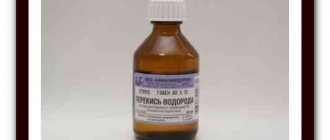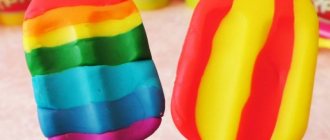What to do first
Fresh iodine stains are easier to remove from clothes than dried ones. In addition, if the drop is not quickly removed, it will spread, leak to the opposite side, and penetrate deeply into the fibers of the fabric.
Immediately after spotting:
- You need to take off your clothes. Gently blot the damaged area with a napkin.
- Cover with starch, soda, and baby powder to absorb any remaining antiseptic.
- For convenience, stretch the cloth over a pan, bucket or jar to prevent iodine from spreading onto the clean cloth.
- If the quality of the material allows, rinse the contamination with boiling water.
- Apply stain remover or home remedy.
If you can’t remove the stains the first time, you should try another method or go to a dry cleaner.
Cleaning leather furniture
You can remove iodine stains from genuine leather furniture using products designed for delicate fabrics. A fresh stain should be blotted with a dry cloth and traces of iodine should be removed with hydrogen peroxide. If such manipulations do not help remove stains, then use special stain removers. After using cleansers, treat the skin with glycerin or fatty cream. This will avoid overdrying of the material and the formation of cracks.
To avoid having to solve the problem of removing iodine stains from fabric, take care of things and carefully use an antiseptic.
We remove iodine stains using traditional methods
There are several quite effective methods, some of them work the first time, while others will have to be tinkered with, but they bring the same result - clean clothes without any signs of contamination.
Laundry soap
Laundry soap remains a popular stain remover. It easily copes with any dirt. Choose a product with the maximum content of fatty acids. Soap marked 72% is considered the highest quality.
How to use:
- Rinse the stained area of fabric with cool water.
- Lather and leave for 10-15 minutes.
- Rub the stain if it is not yet gone.
- Wash your clothes with powder.
The most popular option for removing iodine from bed linen, white and colored clothes is laundry soap.
Acetone
Acetone - perhaps this reagent can be found in any housewife’s house. This method is considered one of the most effective, but it is not suitable for all types of fabrics.
The composition of acetone can damage the integrity of synthetic fibers and deprive the fabric of its brightness. Therefore, the acetone method is not recommended for use on synthetic fabrics.
Removal is quite simple: the reagent is applied to a cotton swab or sponge, after which you need to wipe the area of contamination with gentle circular movements. If the iodine stain cannot be washed off the first time, repeat the procedure. Then resort to your usual hand or machine wash.
Soda and vinegar
If you don’t know how to remove iodine from bed linen, try vinegar and soda. Soda, reacting with acid, copes even with old stains. The method is suitable for dense natural fabrics.
How to use:
- Lay out the clothes and generously sprinkle the stained area with baking soda.
- Pour in vinegar and leave the clothes to soak for 3-4 hours.
- Take a brush and scrub the stain.
- Wash your clothes.
This method is not suitable for delicate synthetic and nylon fabrics, as baking soda and vinegar can damage their structure.
Turpentine
To prepare the active mass, take 35 g of corn or potato starch, add 6 ml of turpentine and 4 ml of ammonia or ammonia. Mix the ingredients and soak the stained area in hot water. Cover the iodine print with the solution and place polyethylene on top. Keep the mixture on black things for 60 minutes.
Then remove micro-residues with a napkin and rub the mark with a toothbrush. When the result is not satisfactory, repeat the manipulation. When removing blots, wash wardrobe items as usual with conditioner.
Hydrogen peroxide
Hydrogen peroxide can remove stains on light-colored items. It discolors the stained area and removes dirt without leaving streaks. Do not use this method for colored fabrics, as the product may ruin the design.
How to use:
- Lay your clothes out on a flat surface.
- Pour some peroxide onto the contaminated area.
- Wait until the stain fades.
- Wash your clothes.
Ammonia
Ammonia is suitable for removing stains on white clothes. You need to stir a spoonful of ammonia in a liter of cold water and treat the stain with this solution. Sometimes it's worth soaking. Leave for about 1.5-3 hours and rinse under cold water. To eliminate the characteristic odor, wash with conditioner.
A large and old stain is treated with ammonia without diluting with water. The procedure will take longer and must be repeated several times.
Dish gel
If you are looking for a way to remove iodine from clothes simply and affordably, use regular dishwashing detergent, which is found in every home. It must be poured onto the contaminated area, left for about 3 hours, and then actively foamed. After half an hour, the fabric is washed in the usual way.
Mole
Dilute ½ teaspoon of pipe cleaner in a glass of water. The contaminant is treated with a pipette. Wait for the iodine imprint to be eliminated and immediately rinse the item of clothing.
On a note! Delay in rinsing threatens to deform the fabric.
Gentle means
- Milk. If contamination from iodine is found on the toilet, you should stock up on milk. The liquid is poured into a basin and the stained area of the product is placed for half an hour. Next, wash with laundry soap. If the stain cannot be removed, a stain remover and a washing machine will come in handy.
- Potato. A proven productive remedy is raw potatoes. Cut the tuber into 2 halves. Use a cut to rub the mark on both sides. The material will turn blue when interacting with potatoes. The blue stains come off when washed.
- Starch. A popular product for removing stains on jeans . Wet the product in water. The stain is sprinkled with powder, thoroughly rubbed into the fabric with a toothbrush, and left until the morning. The chemical reaction will cause the stain to change color to the color of the pants.
- Lemon juice. The contaminated product is treated with juice. Citron juice can be replaced with lemon. Rinse the item with cold water.
- Acetic acid and baking soda solve the problem of old iodine stains. The dirt is covered with soda, onto which a spoonful of acid or vinegar is poured. The soiled T-shirt is washed under running cold water after 3 hours. Then they wash it. The product is also suitable for removing stains from white bed linen.
- Heat. To clean natural material stained with iodine, high temperatures are effective. A light cotton cloth is placed underneath the stained area, covered with the same cloth on top, and ironed for 15 minutes.
- Laundry soap 72%. Places stained with iodine are moistened and wiped with plenty of soap. Wash the item after an hour with washing powder.
- Ammonia. Dilute a spoonful of ammonia in 250 ml of water. A cotton pad is soaked in the solution and the mark is carefully wiped until completely removed. During cleaning, the disk is changed. Leave for 3 hours and wash under running water. To eliminate the specific smell, wash with conditioner. To eliminate old contamination, treatment is carried out with ammonia without adding water. The manipulation will require more time and repeated attempts.
- Glycerol. Place clothes in the washing machine. When traces of iodine form on cotton or linen, adjust the temperature to the maximum. At the end of the cycle, they begin to process the raw blot. Prepare a suspension from 20 ml of purified water, 35 ml of glycerin, and 40 g of chalk. Wipe the area with the mixture, apply cling film to the stain and leave for 5 hours. During this time period, the composition will remove iodine. You will need to rinse the product or wash it by hand or in a machine.
ARTICLE FOR YOU
How and with what to wash and remove stains from deodorant, antiperspirant, eau de toilette and perfume from clothes and linen
How to remove stains using gentle means
Attention! Dry the dress only in the fresh air.
White fabric
The best solution for removing iodine stains on white clothes is ammonia. The main thing here is to use cold working fluid so that iodine particles do not stick to the microscopic fibers of the laundry. If you don’t manage to get rid of the blot the first time, you can soak the item in a solution of ammonia for three hours.
Stain removers and Whiteness can remove stains from a white T-shirt or T-shirt very easily and quickly. In the case of the latter, yellow stains may remain.
Bed sheets
For sewing bed linen, cotton and delicate fabrics are used, which cannot be washed or cleaned with acetone or peroxide. Here you need to use the most gentle preparations: Vanish, stain removers, laundry soap, but with a lower percentage of fat content, dishwashing gel, milk, halves of raw potatoes.
Silk, wool, lace
Traces of iodine from delicate materials should be removed only with high-quality oxygen stain removers with a gentle effect.
Chlorine, aggressive household chemicals, alcohol solutions or acetone are prohibited. It is permissible to treat fresh marks with starch or baking soda (without vinegar!), and gently wash with laundry soap.
The safest option for removing iodine from such clothes is dry cleaning.
Traditional methods
In addition to detergents and solvents, some improvised means of combating traces of iodine have proven themselves to be effective.
Starch will successfully remove the stain from the surface, but will color it blue. Good for rescuing denim clothing. If there is no ready-made starch powder, then raw potatoes can replace it - you need to cut the fruit in half and rub it on the contaminated surface. It will also help out if the question is how to remove iodine from linoleum.
Milk copes with this contamination on clothing and other textiles. Soak it in it for 15-20 minutes, after which the item is washed with laundry soap or hand washing powder.
We recommend: How to remove tea stains from white and colored fabrics
Jeans
High-quality jeans will withstand almost any treatment. Fresh drops can be added:
- starch,
- soda,
- baby powder,
- salt.
Old, dried dirt - try to wipe it off:
- acetone,
- ammonia,
- vinegar.
Do not use chlorine stain removers or wash in very hot water.
Important! Whiteness cannot be used for dark-colored jeans, otherwise the trousers will have to be left for country work.
Glycerin and chalk
Glycerin effectively copes with stains of various origins. It also performs well in removing iodine. For best effectiveness, use it with chalk.
Pros:
- availability;
- ease of use;
- can be used for different fabrics.
- There are practically no downsides to this product, except that it may not completely remove some particularly difficult stains.
Suitable for use on colored and white fabrics.
How to use:
- The item with the stain can be washed in a washing machine at a temperature not exceeding 60°C.
- A mixture of water, glycerin and chalk is prepared.
- The still wet item is rubbed with the resulting composition in the area of contamination.
- The treated stain is covered with plastic film and left for 4-5 hours.
- After this, the item should be rinsed and dried in fresh air.
Good to know for housewives
- You should try to wash off iodine stains immediately after they are planted. Over time, blots are more difficult to wipe off, and in the case of iodine, the matter is already difficult.
- To make it easier to clean the stain, the damaged area of fabric should be stretched on a hard flat surface and walked over it with a sponge or brush.
- You can avoid spreading the stain if you immediately apply the cleaning agent around the stain and wash it with gentle circular movements.
- Before using any product to combat antiseptic stains, you need to test its effect on an inconspicuous area of fabric so as not to spoil the item.
- Never use aggressive stain removers on delicate fabrics. The threads may lose their integrity and the color may fade.
- Iodine stains on denim should not be removed with bleach. In order not to spoil the item, it is better to use home remedies.
- After treating fabric with a strong chemical, you should rinse it and use conditioner to get rid of the strong odor.
- Contamination should be cleaned from the reverse side, placing a piece of light cloth on the front for better absorption.
How to remove iodine stains using stain remover
Household chemicals effectively remove traces of iodine from any material without discoloring or damaging the fabric; they cope well with both fresh and dried, old stains.
| Name | Manufacturer country | Volume | price, rub. |
| Dr. Beckmann "Nature and cosmetics" | Germany | 50 ml | 190 |
| Vanish Gold | USA | 450 ml | 199 |
| Udalix Oxi | Russia | 500 g | 180 |
Gentle products without chlorine-containing bleaching components are suitable for cleaning light-colored, colored and delicate laundry.
Dr. Beckmann
The substances included in the product dissolve coloring pigments without affecting the color and structure of the fabric.
To remove iodine from textiles, you need:
- soak the stain generously with the product;
- leave for 10–30 minutes, depending on the degree of tissue damage;
- blot thoroughly with a napkin;
- wash in the usual way.
The stain remover can be used for dry cleaning, emergency treatment of fresh drops, and removal of old stains.
Vanish Gold
One of the most popular products that effectively deals with stains of any complexity.
Pre-treatment of items with gel will help discolor traces of iodine, and subsequent washing will completely get rid of yellow-brown marks:
- A small amount of the product should be applied to the damaged area.
- Rub the fabric with the bottom of the measuring cap.
- Leave for an hour.
- Wash carefully.
- Without rinsing off the product, put the clothes in the washing machine. Add 100 ml of gel to the drum.
When washing by hand, the same amount of stain remover must be diluted in 4–5 liters of water. If necessary, colored items can be soaked for an additional 1 hour, white items for 5–6 hours.
Udalix Oxi
Universal oxygen stain remover. Depending on the complexity of the stains, it can be used for pre-cleaning damaged areas, soaking, or machine washing.
Read also: Fuel oil stains on clothes can be wiped off using proven methods!
To remove stains you need:
- 3 tbsp. l. the powder must be diluted in 2 liters of warm water;
- soak clothes for 30–45 minutes;
- Rub the yellow marks well with your hands or a clothes brush;
- machine wash.
The maximum effectiveness of the powder is achieved at a temperature of at least 60 degrees. When washed in colder water, it may not be able to remove stains from delicate clothing.
How to get rid of stains - recommendations
To remove iodine contamination, follow these rules:
- The type of material and the condition of the stains determine the selection of the product.
- The use of a cleaning product precedes the test control.
- Synthetics and delicate texture will prevent the use of chemicals and stain removers in the fight against iodine stains, otherwise it will be easy to spoil your outfit.
- Jeans with the addition of synthetics and low-quality coloring, which are subject to molting in lukewarm water, are afraid of interaction with chemicals.
- When working with solvents and aggressive agents, use gloves to protect your hands.
- When iodine gets on your shirt , you need to wash the stain immediately. If there is no possibility of contamination, it is important to blot it with a cotton swab for less impregnation and faster removal.
- The stain is treated from the wrong side, and a cotton napkin is placed on the reverse side.
- To prevent the stain from spreading, wipe it with circular movements from the edge to the middle.
- If iodine is removed from children's clothes or people with allergies, they resort to home remedies.
- The sun's rays help remove the stain . Under the sun, a freshly contaminated area fades. Therefore, after eliminating iodine and washing, it is recommended to dry things in sunlight.
- A fresh iodine stain cannot be cleaned with soap; it creates a thin coating that prevents more powerful products from fighting the stain.
How to remove iodine stains
We recommend: Dandelion stains are not a problem!
